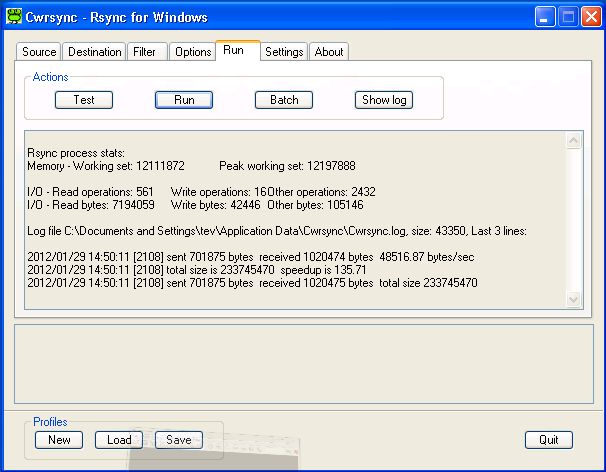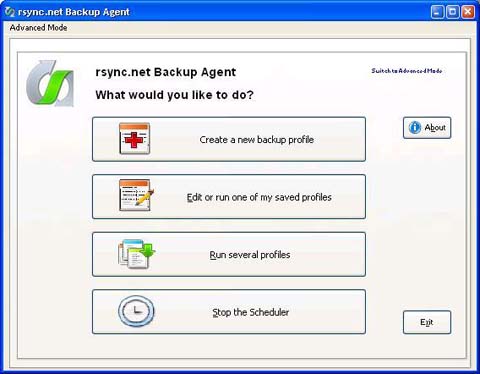Rsync is a utility for efficiently transferring and synchronizing files between a computer and an external hard drive and across networked computers by comparing the modification times and sizes of files. It is commonly found on Unix-like operating systems. The rsync algorithm is a type of delta encoding, and is used for minimizing network usage. Although rsync is built to run on Unix-like systems, there’s no reason that you shouldn’t be able to use it just as easily on Windows. Cygwin produces a wonderful Linux API that we can use to run rsync, so head over to their website and download the 32-bit or 64-bit version, depending on your computer.
It seems that rsync is the de-facto standard for efficient file backup and sync in Unix/Linux.
Does anyone have any thoughts on why it wouldn't have caught on in the Windows world?
- Unlike 'rsync', DeltaCopy is a only available for Windows and is tightly integrated with services available only on Microsoft platforms (XP, 2000, 2003, Vista, Windows 7 & 2008). Here is a list of features Incremental backup - Copies part of the file that is actually modified; Task scheduler - Profiles in DeltaCopy can run based on a schedule.
- Acrosync for Windows can sync entire folders with any Linux/Mac/NAS without installing server software. That is because it is the only native Windows implementation of rsync, a powerful folder sync tool that is ubiquitously installed by default in the non-Windows world.
Why hasn't it become a universal 'protocol' for file sync?
closed as off topic by user619714Mar 8 '12 at 21:58
Questions on Server Fault are expected to relate to server, networking, or related infrastructure administration within the scope defined by the community. Consider editing the question or leaving comments for improvement if you believe the question can be reworded to fit within the scope. Read more about reopening questions here. If this question can be reworded to fit the rules in the help center, please edit the question.
locked by Michael Hampton♦Apr 17 '18 at 15:01
This question exists because it has historical significance, but it is not considered a good, on-topic question for this site so please do not use it as evidence that you can ask similar questions here. This question and its answers are frozen and cannot be changed. See the help center for guidance on writing a good question.
Read more about locked posts here.
18 Answers
I would say mostly because people in windows are unaware of it. Rsync is a command-line utility that is consistent with the unix philosophy of having lots of small tools preinstalled. The windows philosophy is based around GUI applications that are all downloaded and installed separately. There is not a smooth integration spot where rsync would be obvious or make much sense, and running commands on a windows system is tedious at best.
Also, rsync really shines when its part of a larger application (say for consolidating and parsing logs), or as an automated archival system (implemented easily with a cronjob). Windows simply doesnt have the other tools in its ecosystem to make using rsync actually viable.
Finally, I would say that rsync is just too freaking complicated. Anyone I know who uses it regularly has a pre-set group of flags (mine is -avuz) that generally does what they want, but the man pages / documentation lists dozens of command-line switches, some of them amalgamations of other switches. For example (from the [man page][1]):
-a, --archive: archive mode; equals -rlptgoD (no -H,-A,-X)
It is a quick way of saying you want recursion and want to preserve almost everything (with -H being a notable omission). The only exception to the above equivalence is when --files-from is specified, in which case -r is not implied.
Windows users generally expect, well, windows, and menus, and to have a single app be an all-in-one solution, not just an independent piece of a tool chain.
I'm suprised no-one has mentioned DeltaCopy, which is rsync packaged in a windows GUI. It can even install itself as an rsyncd-compatible service.
In my opinion, because there is no decent GUI.
Another argument may be that there is robocopy.Robocopy is missing many cool features that rsync offers, but in most situations robocopy is just sufficient for the job at hand.
I use the Cygwin rsync extensively and it works very well.
But ..
It is a bugger to install and configure. You have to do a full Cygwin install just to get one binary and three dlls, and it isn't obvious which three dlls are needed. How to run it as a service is not obvious and the command line syntax is complex. Non-nerds are like to give up very quickly.
Also it messes up permissions to the point where I always set cygwin=nontsec, and it regularly hangs. I understand the hang is a known problem with the Cygwin dll rather than rsync itself (which is not a criticism of the Cygwin guys. What they've achieved is little short of miraculous!).
Rsync is extremely useful if you do any sort of replication over WAN links, and it's on my todo list to write a native Win32 version. Sadly it's been on my todo list for several years and is no closer to the top. I don't think just writing a GUI wrapper is a big step forward as fails to address some of the fundamental problems with the Cygwin version.
If anyone is interested, http://www.ratsauce.co.uk/notablog/UsingRsync.asp describes the results of my many hours of pain getting Cygwin rsync to work on Windows.
JR
Ios 10 beta software profile. If you forget your passcode,. If you’re prompted for your device passcode or to Trust This Computer, follow the onscreen steps.
I would say that for smaller computer to computer syncs, people are using Robocopy, SyncToy, or Foldershare (now Live Sync). For the large enterprise distributed multimaster file share scenarios, they are using Distributed File System (DFS). Those tools handle most sync scenarios just fine, leaving very little benefit to installing, learning, and using a recompiled *nix app on Windows.
IMO:

rsync is far less likely to be installed on machines one comes across in the Windows world while the Resource Kit with robocopy is often installed (or at least it's on an 'approved' list of software that can be installed on a production system).
As others have pointed out, robocopy is generally more than adequate to skin whatever cat is at hand. It may not be quite as nice as rsync but it's a good tool.
Lack of GUI may be a factor but even though there's a front-end available for robocopy, I find that most folks figure out the robocopy switches needed and stick it in a .bat file.
I use robocopy in windows - which comes preinstalled in windows vista and windows 7, and is up to any backup situation I encountered so far.
Rsync In Windows 8
My guess is that it simply doesn't have a GUI. For easy sync tasks Microsoft even offers Sync Toy, and rsync could do much more ..
For what it's worh, there is a perfectly functional rsync for Windows that does not need installation of Cygwin. I have been using it to backup different parts of my data to different drives. It is useful to exclude particular directories, but probably other utilities do it also.
Rsync Windows Gui

Nestor
Oh boy, you guys have obviously been missing the utility 'Unison'. I've been supporting some major US/EUR 'realtime' infrastructures and I have to say everyone has very similar problems.. how to replicate and be able to be active-active all the time.. if you don't care about session persistence then this thing is the bomb.. best thing I've found in solaris extras :-)
The easiest to use/install rsync GUI application I've found for Windows has been grSync.
(Screenshots: http://www.opbyte.it/grsync/screenshot.html)
If it were more popular, maybe rsync would be used more.
I belive rsync can be used under cygwin in windows world :) cygwin is easy to install and use, however for ordinary users who love GUIs it is not very common. so we get two barriers:
1) lack of GUI frontend
2) even if there was a GUI frontend in tcl/tk for example - the need to install cygwin is a barrier.
and rsync is not proprietary software which wants to sell itself and therefore struggles to eliminate barriers before potential customers. As Joel sais: eliminating one barrier doubles your userbase. So here we have barriers for windows users - as a consequence small userbase on Windows platform.
I use robocopy for rsync-like behavior in windows.
Basically, I wrote a backup.bat file that I have on an external drive.I regularly run the file to back my desktops up to the external drive.Then I store the external drive in a fireproof safe.
We built a GUI for Rsync and Windows.
The computer/backup server you connect to needs to be running SSH and Rsync.
Let me know if you have questions by commenting on this answer.
Exact same reason tar and bzip2 are unheard of. It very much doesn't fit into Windows well. zipping a directory and shuttling it over SMB fits into Windows better, and seems almost as fast in numerous cases. That's not really my dream for a better world, but it's a reality to grapple with. Most all windows machines don't have any unix layer installed. Unlike, Mac OS X.
There are some newer rsync guis in development. One I came across recently through wikipedia is yintersync. It looks pretty comprehensive as a gui for rsync on windows and rather neatly also supports shadow copies for replicating live files.
I have recently tested this on my work dr system with good results. It has a built in scheduler and email reports. This may help rsync catch on finally to the windows crowd
The lack of gui is not really a problem. xacls, robocopy, net, sc are very usefull and don't have any gui.I believe that if rsync is not used, it is more due to the fact that:
- Windows lacks a real shell and a real scripting language. And people that use batch are also using robocopy.
- Since 95, Windows comes with an easy-to-use graphical tool (named 'Porte document' in the french version). Since Windows 2000 (or XP?), there is a 'synchronise' menu in the explorer.